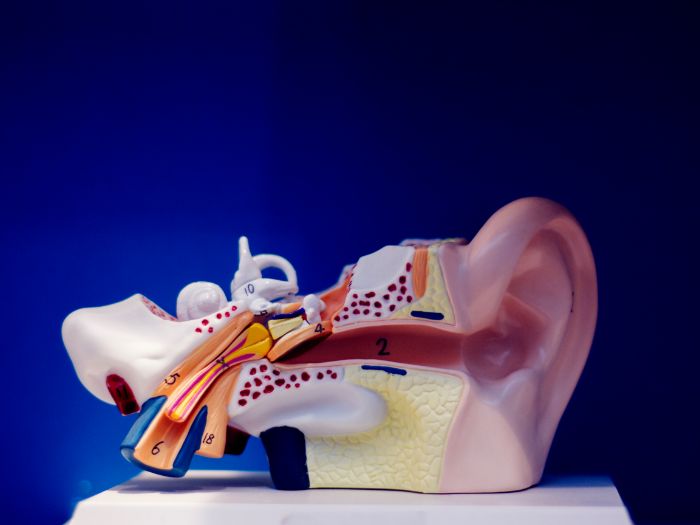Cochlear implants have revolutionised the way we treat severe to profound hearing loss. These devices bypass damaged parts of the inner ear and directly stimulate the auditory nerve, enabling individuals with hearing loss to perceive sound. However, determining whether a person is suitable for a cochlear implant requires a thorough evaluation of their auditory system. One of the tools utilised in some of the assessment processes is Otoacoustic Emissions (OAEs) testing.
What are OAEs, and how are they generated in the ear?
OAEs are sounds generated by the inner ear in response to external stimuli. These emissions can be measured using sensitive microphones placed in the ear canal. OAEs result from the movement of outer hair cells from an intact cochlea when being stimulated by external sound.
When sound enters the ear, it causes the basilar membrane within the cochlea to move. This movement drives the movement of the outer hair cells which sit on top of it and thus sends the electrical signal to the auditory nerve and to the brain. The movement of the outer hair cells emits sound back into the ear canal and is being picked up by a microphone. These emissions are analysed to provide valuable information about the integrity of the cochlea.
The significance of OAE testing in cochlear implant candidacy evaluation
OAE testing plays a crucial role in the assessment of cochlear implant candidacy. It provides valuable information about the integrity of the cochlea and the functioning of the outer hair cells. However, it is not necessarily required for testing all the patients.
Here are some circumstances OAE testing is essential in this evaluation:
- Objective assessment: OAE testing provides an objective measure of the cochlear function, independent of a person’s response or subjective feedback. This is particularly valuable when evaluating infants, young children, or individuals with cognitive communication or behavioural difficulties.
- Differential Diagnosis: In certain cases, such as to diagnose Auditory Neuropathy Spectrum Disorder (ANSD), non-organic hearing loss etc, OAE plays a great role in providing differential diagnosis. It provides invaluable information about the integrity of the cochlea and in combination with other audiological assessments which confirm the auditory disorder and severity of hearing loss. Thus, it is important in planning further intervention which is most suitable for the patients.
How do OAEs differ from pure tone audiometry?
While traditional hearing tests like pure-tone audiometry and speech audiometry evaluate a person’s hearing abilities, OAE testing provides complementary information about the integrity of the cochlea and the functioning of the outer hair cells.
Here are some critical differences between OAE testing and traditional hearing tests:
Mechanism of measurement: Traditional hearing tests involve presenting sounds to the individual and measuring their behavioural response or perception of those sounds. In contrast, OAE testing measures the sounds generated by the individual’s hearing organ in response to external stimuli.
Objective vs subjective: OAE testing provides an objective measure of cochlear function, as the emissions are measured using sensitive equipment. In contrast, traditional hearing tests rely on the individual’s subjective responses or feedback.
Sensitivity to different hearing problems: OAE testing can detect subtle cochlear dysfunction that may not be identified through traditional hearing tests alone. OAEs are particularly sensitive to the functioning of the outer hair cells, making them useful in detecting early signs of cochlear damage or dysfunction such as noise-induced hearing loss & ototoxic hearing loss, even when pure-tone audiometry results appear normal.
Age and developmental considerations: OAE testing is well-suited for assessing the auditory system of infants, young children, and individuals with communication, behavioural or cognitive impairments. Since it is an objective measure, it can provide valuable information even in cases where the individual cannot actively participate in traditional hearing tests.
What Listening Lab Singapore does?
Listening Lab Singapore specialises in comprehensive hearing assessments and solutions, including cochlear implant candidacy evaluations.
Listening Lab Singapore can assist in the assessment process:
a. OAE testing: Listening Lab Singapore offers OAE testing for their cochlear implant candidacy evaluation when necessary. Their experienced audiologists use equipment to accurately measure otoacoustic emissions, providing valuable information about cochlea’s health and outer hair cell function.
b. Evaluation: The team at Listening Lab Singapore consists of audiologists who specialise in audiological assessments. They have extensive experience interpreting OAE and other audiological test results and can comprehensively provide a differential diagnosis.
c. Personalised recommendations: Based on the results of the OAE testing and other assessments, Listening Lab Singapore can provide personalised recommendations regarding hearing aid or cochlear implant candidacy. They consider various factors, such as the individual’s hearing loss severity, communication needs, and potential benefits of different hearing devices.
d. Post-implantation support: Listening Lab Singapore provides ongoing support throughout the implantation process if a person is deemed suitable for a cochlear implant. This includes assistance with device selection, mapping, and rehabilitation to optimise hearing outcomes.
OAEs are valuable tools in assessing cochlear function when someone cannot provide reliable responses and when suspecting the presence of other auditory disorders. They provide objective information about cochlear health and outer hair cell function, helping in providing accurate hearing related diagnosis and recommendations.
Listening Lab Singapore offers OAE consultation and evaluation to support the audiological assessment process, providing personalised recommendations and comprehensive post-implantation support. Enquire today to make informed decisions about your hearing healthcare journey by understanding OAEs and leveraging their role in audiological assessment.
